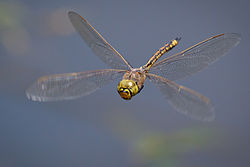| Australian emperor | |
|---|---|
 | |
| Scientific classification | |
| Kingdom: | Animalia |
| Phylum: | Arthropoda |
| Class: | Insecta |
| Order: | Odonata |
| Infraorder: | Anisoptera |
| Family: | Aeshnidae |
| Genus: | Anax |
| Species: | A. papuensis |
| Binomial name | |
| Anax papuensis (Burmeister, 1839) [2] | |
 | |
| Synonyms [3] | |
| |
The Australian emperor dragonfly, [4] also known as the yellow emperor dragonfly, [5] the Baron Dragonfly in New Zealand, [6] scientific name Anax papuensis, is a species of dragonfly in the Aeshnidae family. [3] It is black with yellow dots along its tail. [7]







